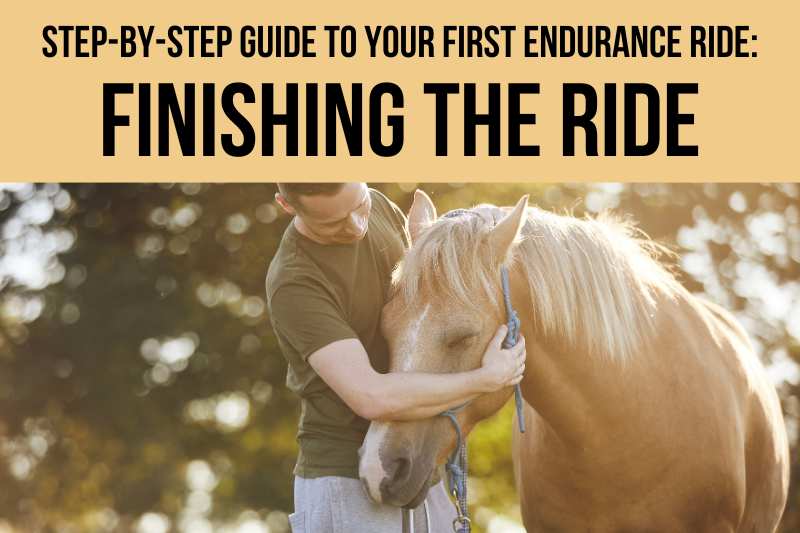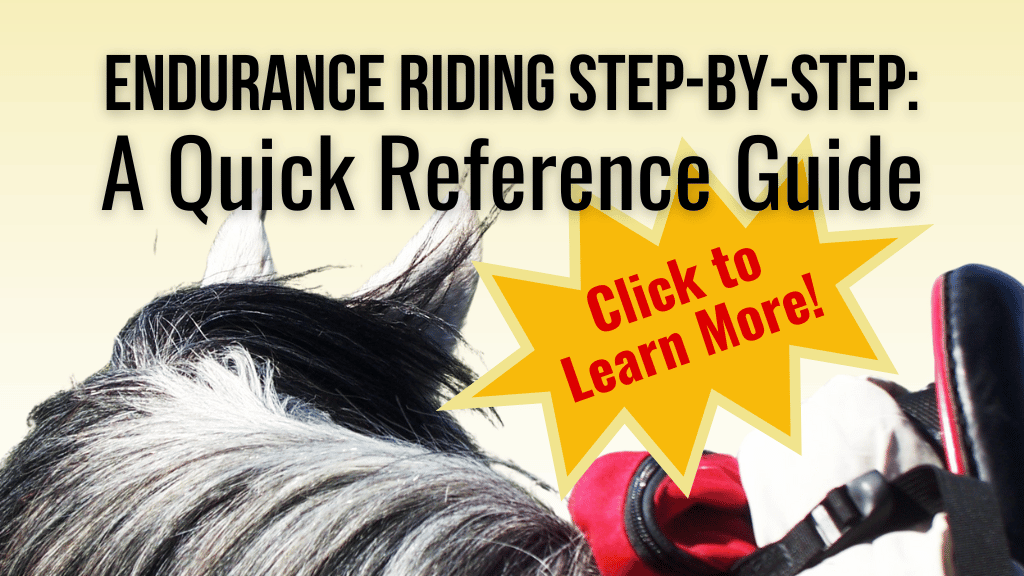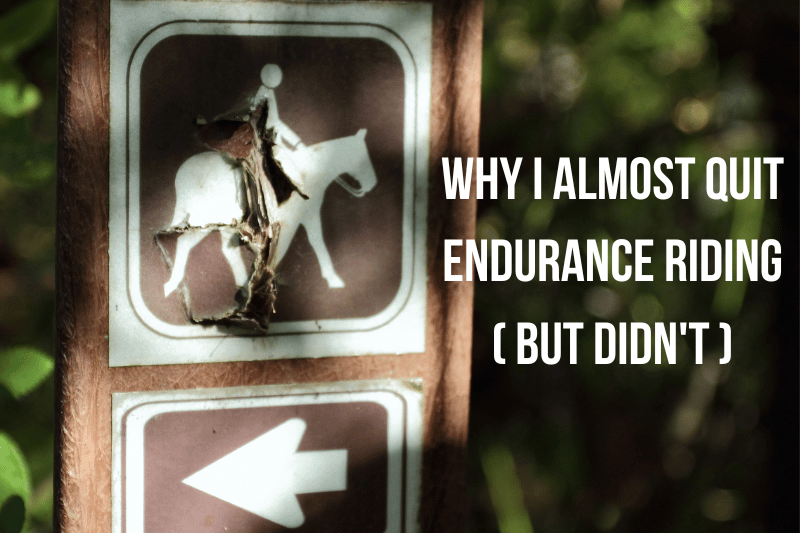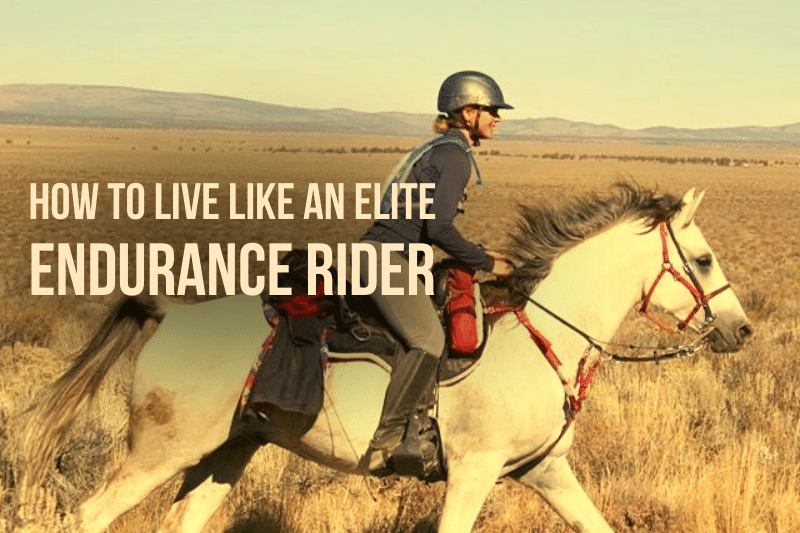You did it! All those daunting, exhilarating, exhausing miles are behind you, and ride camp is coming into view. This article covers how to finish your endurance ride and follow up with the care needed to keep yourself and your horse going strong.
Did you catch the earlier posts in this series?
Part 1: Step-By-Step Guide: Before Leaving Home
Part 2: Step-By-Step Guide: Arriving in Ride Camp
Part 3: Step-By-Step Guide: The Evening Before
Finish Line & Finish Time
One of the best things about endurance is that pretty much everyone wants to see you succeed. As you approach the finish line, you’ll be greeted by a smattering of cheers and applause from the timers and pulsers, plus anyone else who happens to be in the vicinity.
You’re not quite done, though!
Proceed to the timer and call out your number, just as you did when coming into the holds. Your arrival time will be noted because, once again, your horse needs to pulse down within 30 minutes to avoid being pulled.
The reason for this rule is to discourage riders from pushing their horses too fast on the last loop in order to win or place. The rules for Limited Distance rides further emphasize this point by establishing that a horse’s finish time corresponds to his down time rather than his arrival time.
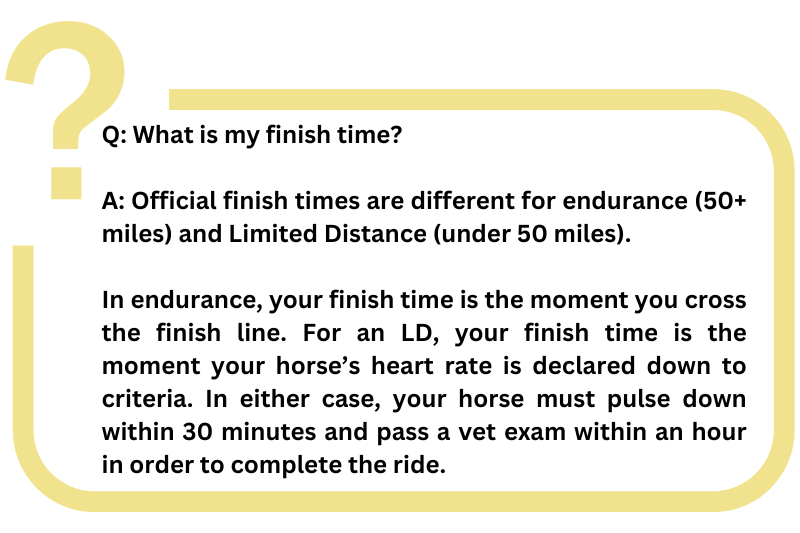
The Completion Exam
Every horse at the finish of an endurance or LD ride needs to be judged “fit to continue,” even though he won’t actually be going on.
You must visit the vet for your horse’s completion exam within one hour of crossing the finish line. (This is true for both endurance and LD, even though their finish times are determined differently.) It’s usually best to go the vet right after pulsing down because your horse will stiffen up if he stands around for a while first.
The completion exam will look almost exactly like the pre-ride exam and vet checks during holds, except that you will probably be asked to remove your horse’s tack. This allows the vet to inspect for back soreness, girth rubs, and any other issues that could be covered up by a saddle.
If it’s cold out, have a fleece cooler handy to cover your horse’s sweaty back as soon as you pull his tack so he doesn’t get chilled or crampy. (This is a good reason to stash your crew bag near the P&R area ahead of time.) You’ll need to remove the cooler during the actual vetting, but it can protect your horse while you wait in line, and again as soon as the vet is finished.
If all goes well, the smiling vet will complete your horses’ exam, hand you your ride card, and declare that you have earned your completion. Congratulations!
Care for Your Horse
Your ride is done, but your job as the rider is not. Taking care of your horse will help him recover as quickly as possible, with minimal soreness and maximum fitness boost.
Feed and water – The first order of business is to let your horse eat and drink his fill. A mash of familiar feeds, plus unlimited hay, should look really good to him about now.
Electrolyte – Many riders provide additional electrolytes post-ride. Although the horse will replenish electrolytes naturally from feed, doing so takes longer than if you supplement. Bear in mind that your horse’s system will face further taxing during the trailer ride home, so supporting his recovery is probably a good idea.
Banned treatments and substances – Once your ride is complete, you are free to administer banned treatments and substances (think sucralfate, PEMF, etc.)
A few caveats:
If you finished in the top 10, you’ll be eligible to show for Best Condition. Doing so is optional, but it’s a great way to gather data on your horse. How to show for BC is beyond the scope of this post, but be aware that if you choose to show, you are still considered entered in the ride (so no banned treatments) until after the BC judging.
If you are at a multi-day event and plan to ride the next day, your completion exam will also serve as your pre-ride exam for tomorrow. That means you are done with today’s ride but starting tomorrow’s…so, no banned treatments or substances.
Clean him up – After leaving him alone to rest and eat for a half hour or so, take time to clean your horse up. Sponging or brushing away sweat and mud will go a long way toward helping him feel refreshed. If it’s chilly out, forgo the sponging. If you wouldn’t want to be standing around wet, your horse probably wouldn’t, either!
Care for his legs – Some riders wrap their horses’ legs after an endurance ride, while others feel this is counterproductive because it traps heat. Most choose some sort of cooling and bracing method, like liniment or clay poultice. (If you’re riding the next day, check those labels! Many liniments and poultices contain banned substances like arnica.)
Ice boots are fantastic, though they present a logistical challenge because most of us don’t bring large freezers to ride camp. The tips in my article on How to Pack a Cooler and Keep it Cold Longer than You Ever Thought Possible will yield best results.
Another option is to have your horse stand in a nearby creek for 20 minutes or so post-ride.
Mind his temperature – If you’ve ever participated in endurance athletics of your own, you may have experienced the body temperature dysregulation that can follow a hard effort. Your horse may get chilled more easily than usual in his depleted state. Be prepared to help him out with blankets, especially if it’s windy, rainy, or cold as evening approaches.
Take walks – Both you and your horse will stiffen up as you stand still post-ride. Periodic handwalks around camp will go a long way toward helping both of you recover. It’ll also give you opportunities to chat with other riders and catch up on stories from the day’s adventure.
Stay in camp – It may be tempting to drive home after a ride, especially in bad weather. However, unless your horse finished very strong and home is nearby (within a 90-minute drive), it’s almost always best to spend the night in camp.
Riding in the trailer is work for your horse, comparable to walking for a similar amount of time. If you do haul out post-ride, give your horse at least a couple hours’ rest before loading him up.
Remain vigilant – Occasionally, a horse’s metabolic state will go downhill after completion. Keep an eye on your horse to ensure that he is eating, drinking, and resting comfortably. If you’re concerned, take him back to the vet. Anything that happens now won’t affect your completion, and getting prompt care could save your horse’s life.
Care for Yourself
Eat carbohydrates – Don’t wait for dinner to refuel your body. Your body’s glycogen stores are likely low, and consuming some carbohydrates shortly after the ride will replenish them quickly. This, in turn, will contribute to quicker recovery from the day’s effort.
Eat protein – Add some protein to give your body the building blocks needed to repair your hardworking tissues. Animal proteins are the most bio-available option, and they include all 9 essential amino acids (the ones your body can’t manufacture on its own). Branch-chain amino acids (BCAAs) — especially lysine — are especially important for recovery. A good BCAA supplement can help replenish your body quickly.
Keep hydrating – Despite your best efforts, you are probably behind on hydration after your long day. Remember that hydration requires both water and electrolytes. UCAN has a new product out that includes both electrolytes and BCAAs. I am super excited to try Hydrate + Aminos!
Prepare for departure – If you want to get an early start in the morning, you can help yourself out by breaking down a lot of your camp setup ahead of time.
Be sure to follow any guidance from the ride manager about cleaning up your camping area. Many rides require you to haul out manure and hay; others need it to be scattered so that no large clumps remain. It’s critical that all riders do their part to ensure the continued availability of ride camps in future years.
Attend the Awards Ceremony
Sometime in the evening, a casual awards ceremony will be held. Just as with the pre-ride meeting, covered in the Step-By-Step Guide: The Evening Before, you should leave your horse but take your chair, plus maybe a drink and a jacket.
Everyone who completed the ride will receive an award. These completion awards are never worth overriding your horse for, but you might be surprised how much you treasure that token hoof pick or t-shirt. The manager may also give out special awards for Best Condition, Top 10, Turtle (last place), and junior riders.
When the ride manager calls your name, be prepared for people to clap as you step up to claim your treasure.
Incidentally, there’s an old tradition of dunking a rider in a water trough to celebrate her first completion. It rarely happens these days, but keep your eyes peeled if you have those types of friends!
What if you didn’t complete? Go to the meeting anyway. Every experienced endurance rider has been pulled at some point. As long as you did your best to prioritize your horse’s safety, nobody (at least, nobody whose opinion matters) will think poorly of you.
Ask and you shall receive! Introducing The Quick-Reference Guide
Many of you reached out to me about getting the content in this series in a consolidated format for easy reference beyond the reach of wi-fi or cell service. Wish granted!
I’ve distilled the key points from all six Step-by-Step articles into a checklist-style Quick Reference Guide. Just download it to your phone and use the clickable Table of Contents for speedy access to the information you need, when you need it. It’ll print nicely, too, if you prefer a hard copy.
The Quick Reference Guide also includes three bonus resources: an Endurance Rider Food Guide, Endurance Ride Packing List, and my I.C.E. Pack for Endurance Riders.
You can download the entire Guide, plus bonuses, for just $5.99. Although it’s technically a purchase, I think of it more like a donation to support this website as a free resource. I surely appreciate it! Click below to learn more and order yours today.
Traveling Home
In the morning, most riders will be packing up. Quite a few will roll out early, with long drives ahead. Taking your horse for a walk before putting him in the trailer will give you a chance to wave good-bye to friends. Also, be sure to thank the ride manager!
On your way home the next day, take more breaks than usual, especially if you have a very long drive. Parking for 10-15 minutes will give your horse a nice rest, and unloading every 3-4 hours for a little walk will feel good for everyone.
You can encourage your horse to drink on the road by mixing a handful of rice bran into a bucket of water.
Back at the Ranch
Give your horse some time off – An extended recovery period will help him to gain the maximum fitness benefit from his big workout. It’ll also allow any brewing issues to heal instead of turning into full-blown injuries.
A common rule of thumb is to give your horse one week off for every 25 miles ridden. So, he’d get a week off after an LD and two weeks off after a 50. Bear in mind that horses don’t lose their fitness nearly as quickly as humans do, and they seem to benefit even more than we do from plenty of rest.
“Rest” doesn’t mean standing around in a stall, though. Find ways for your horse to move, either through abundant turnout or gentle hacks.
Remember to adjust your horse’s feed during his rest period. Continuing to feed as though he were in heavy work – especially if you normally give him concentrated carbohydrates like grain – can cause him to tie up when you do resume work. Unlimited forage is fine, but back way off any concentrates.
Complete your ulcer prevention protocol – If you had your horse on UlcerGard before and during the ride, it’s generally a good idea to keep him on it for a day or two after getting home. Due to concern about gastric acid rebound following omeprazole use, many riders taper the dose for several days before quitting it completely.
You can also support your horse through this process with protective substances like sucralfate, Neigh-Lox, Outlast, Visceral+ or SmartGut Ultra.
Interestingly, a study on SmartGut Ultra used gastroscopy to demonstrate that the product does help protect horses’ stomachs from acid rebound after treatment with omeprazole.
Similarly, Visceral+ by Mad Barn was studied for efficacy in horses with gastric ulcers. Horses were treated with omeprazole, then given Visceral+ after the treatment stopped. Before and after scoping showed either improved or resolved ulcers in all subjects.
Tidy up for next time – While your horse rests, take the time to clean out your horse trailer, wash tack, rinse boots and buckets, and generally leave yourself a clean slate for the next ride. As you tidy, make a list of things to fix, change, order, or pack for next time.
Reflect – Over the next week or so, spend some quiet time pondering your ride experience. Were you happy with how you managed yourself and your horse? Did you experience mental or physical discomfort that could be addressed for next time? Should you focus on some extra training for your horse? Were you happy with your own fitness and knowledge?
Celebrate – Don’t forget to share your success! Post your ride photo on social media and brag a bit.
Repeat – While you’re online, head over to the ride calendar and pick your next event!
Hey! First time visiting the blog? START HERE to learn what The Sweaty Equestrian is all about!
Also, have you signed up for my bi-monthly newsletter? If not, you’re missing out on subscriber-only content. It’s like getting two extra blog posts per month!
You might also like
This post includes affiliate links, and I may earn a small commission (at no extra cost to you) when you purchase through these links. I only recommend products and services I think are helpful and useful. Thanks for helping me offset the cost of maintaining this blog as a free resource!

